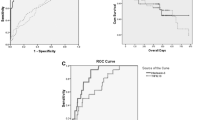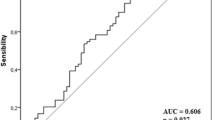Abstract
To evaluate serum levels of IL6 in patients with Kawasaki disease and compare it with CRP, and to assess the role of these biomarkers in predicting coronary changes and resistance to the first-line therapy of this disease in a subset of Indian population. A single centre prospective observational study was conducted amongst all Kawasaki disease patients for a period of 18 months from January 2017 at Institute of Child Health, Kolkata. Serum IL6 and CRP were compared at diagnosis and after 48 h of administering IVIG in patients who developed coronary changes with those who did not and also among the responders and non-responders to IVIG, the first-line therapy given to these patients. Out of total 72 patients of KD [mean age of presentation: 24 months, M:F = 1.22:1], 30% (n = 22) had coronary artery involvement (CALs), and 15% (n = 11) were IVIG non-responders. Mean IL6 prior to IVIG in those with CALs was 143.60 pg/ml, which was about three times higher than in those without CALs (mean = 52.90 pg/ml), the difference being significant (p < 0.01). Mean CRP values also were significantly raised in patients with CALs (p < 0.01) whereas post-IVIG levels of mean serum IL6 was found to be 108.15 pg/ml in non-responders which was about 17 times raised than that in the responders (mean IL6 = 6.22),the difference again was statistically significant (p < 0.001).Also, ROC analysis revealed a sensitivity and specificity of 81.0% and 82.0%, respectively, for IL6; 72% and 74%, respectively, for CRP for predicting CALs. This study also shows a sensitivity of 72% and specificity of 68% for IL6 in predicting IVIG resistance whereas that of CRP being 90% sensitive and 36% specific. These results suggest that higher levels of IL-6 and CRP at diagnosis are associated with occurrence of CALs and IVIG resistance in KD patients. Using the cutoff for IL6 and CRP from our study, chances of developing CALs and IVIG resistance can be predicted, which might prevent the development of future complications like aneurysms in such patients.

Similar content being viewed by others
References
Kawasaki T (1967) Acute febrile mucocutaneous syndrome with lymphoid involvement with specific desquamation of the fingers and toes in children. Jpn J Allergol 16:178–222
Jamieson N, Singh-Grewal D (2013) Kawasaki disease: a clinician’s update. Int J Pediatr 2013:645391
Manlhiot C, Christie E, McCrindle BW, Rosenberg H, Chahal N, Yeung RS (2012) Complete and incomplete Kawasaki disease: two sides of the same coin. Eur J Pediatr 171:657–662
Clark SC (1989) Interleukin-6. Multiple activities in regulation of the hematopoietic and immune systems. Ann NY Acad Sci 557:438–443
McCrindle BW, Rowley AH, Newburger JW, Burns JC, Bolger AF, Gewitz M, Baker AL, Jackson MA, Takahashi M, Shah PB, Kobayashi T, Wu MH, Saji TT, Pahl E, American Heart Association Rheumatic Fever, Endocarditis, and Kawasaki Disease Committee of the Council on Cardiovascular Disease in the Young; Council on Cardiovascular and Stroke Nursing; Council on Cardiovascular Surgery and Anesthesia; and Council on Epidemiology and Prevention (2017) Diagnosis, treatment, and long-term management of kawasaki disease: a scientific statement for health professionals from the american heart association. Circulation 135(17):e927–e999. https://doi.org/10.1161/CIR.0000000000000484
Egami K, Muta H, Ishii M et al (2006) Prediction of resistance to intravenous immunoglobulin treatment in patients with Kawasaki disease. J Pediatr 149:237–240
Suganami Y, Kawashima H, Hasegawa D et al (2008) Clinical application of rapid assay of serum interleukin-6 in Kawasaki disease. Pediatr Int 50:264–266
Hirano T, Yasukawa K, Harada H, Taga T, Watanabe Y, Matsuda T, Kashiwamura S, Nakajima K, Koyama K, Iwamatsu A et al (1986) Complementary DNA for a novel human interleukin (BSF-2) that induces B lymphocytes to produce immunoglobulin. Nature 324(6092):73–76
Kim DS (1992) Serum interleukin-6 in Kawasaki disease. Yonsei Med J 33(2):183–188
Rawat Amit, Singh Surjit (2015) Biomarkers for diagnosis of kawasaki disease. Indian Pediatr 52:473–474. https://doi.org/10.1007/s13312-015-0658-2
Sato S, Kawashima H, Kashiwagi Y, Hoshika A (2013) Inflammatory cytokines as predictors of resistance to intravenous immunoglobulin therapy in Kawasaki disease patients. Int J Rheum Dis 16:168–172
Wang Y, Wang W, Gong F, Fu S, Zhang Q, Hu J (2013) Evaluation of intravenous immunoglobulin resistance and coronary artery lesions in relation to Th1/Th2 cytokine profiles in patients with kawasaki disease. Arthritis Rhuem 65(3):805–814
Funding
None.
Author information
Authors and Affiliations
Corresponding author
Ethics declarations
Conflict of interest
The above authors Dr. Alolika Nandi, Dr. Priyankar Pal and Dr. Surupa Basu declare that there is no conflict of interest.
Additional information
Publisher's Note
Springer Nature remains neutral with regard to jurisdictional claims in published maps and institutional affiliations.
Rights and permissions
About this article
Cite this article
Nandi, A., Pal, P. & Basu, S. A comparison of serum IL6 and CRP levels with respect to coronary changes and treatment response in Kawasaki disease patients: a prospective study. Rheumatol Int 39, 1797–1801 (2019). https://doi.org/10.1007/s00296-019-04375-9
Received:
Accepted:
Published:
Issue Date:
DOI: https://doi.org/10.1007/s00296-019-04375-9




